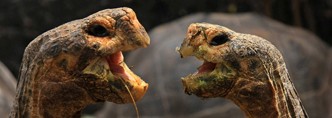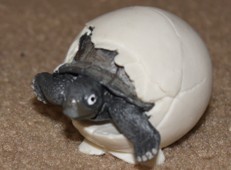Bringing Back Baby (Tortoises)

By Merry Morris
Pity the plight of the poor Galapagos tortoises. The past several hundred years have been tough. Their population, once estimated up to 250,000, has dropped precipitously. Whalers and pirates in the 1600s, 1700s and later, found these ancient creatures a meaty and easy-to-maintain food source for their voyages — tortoises could survive for long periods on a ship without food and water.
Many years later, researchers noted no new tortoise babies were surviving to replenish the diminishing tortoise population. Though these reptiles have long lives, without new offspring to replenish the population, their total numbers plummeted, making them one of the oldest and most endangered species. Not all the damage came from humans, though.
Something Had To Be Done… About Those Rats!
In some cases, rats are part of a balanced ecosystem, but on the Galapagos Islands these invaders were a scourge to the vigorous turtle population.
Rats are not native to the Galapagos Archipelago, but were carried to the isolated islands by whalers and privateers. A pirate’s life, contrary to the swashbuckling movies, was not pleasant — disease, rotten food, limited hygiene opportunities and rats. One of the least favorite assignments was going on rat patrol, ridding the ship of as many rats as possible (a Spanish galleon recounted killing literally thousands of rats as it sailed back to Europe from the Caribbean).
The Galapagos Islands provided a fine haven for escaping rats. Rats found the habitat quite pleasant, and the food sources plentiful. With few enemies and ample food, including tasty turtle eggs, the rat’s numbers exploded.

Conservationists recognized the critical nature of the declining numbers of tortoises and began efforts to reduce the rat damage. For fifty years, their diligent efforts included snatching the buried tortoise eggs before the rats could devour them and raising hatchlings in the lab until they were older and less vulnerable to the rats.
Despite these efforts, they realized the rats had to go. In 2012, on the island of Pinzón, the war on rats began. Conservationists spread poisoned bait over the surface of the island’s volcano and awaited the results.
The Babies Are Back
Last December, success was apparent with the sighting of 10 newly hatched saddleback tortoises on Pinzón. These hatchlings had survived on their own without the benefit of human protection! For conservationists, who believe no new turtles had survived on their own in the past 150 years, it must have been an amazing sight. Considering these reptiles can live more than a hundred years, the 10 survivors may promise higher populations for years in the future.
Extension Questions
- Review how tortoises lay their eggs — how many, how long is incubation, what is the survival rate?
- Investigate the history and geography of the Galapagos Archipelago
- Were rats the only problem for tortoises on the islands? Consider what other invasive species had done in the Galapagos.

